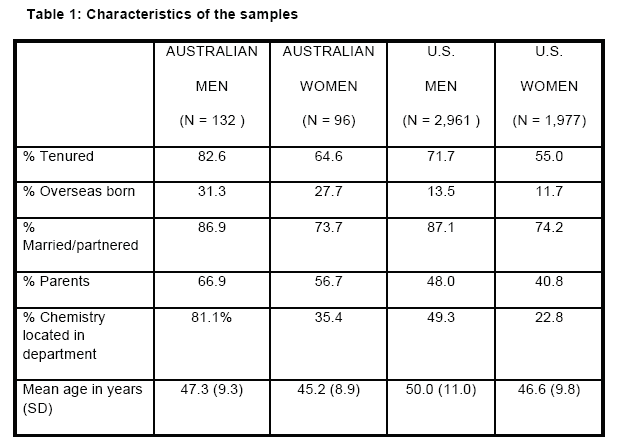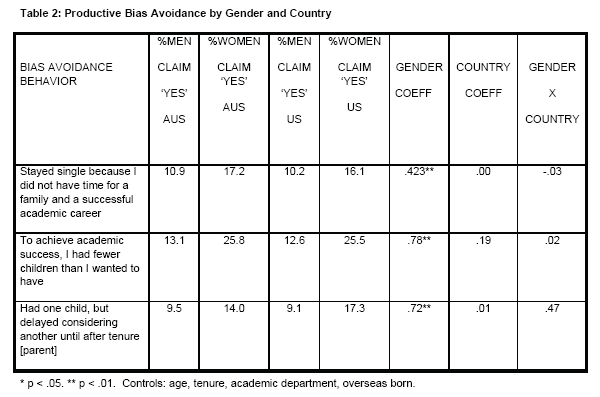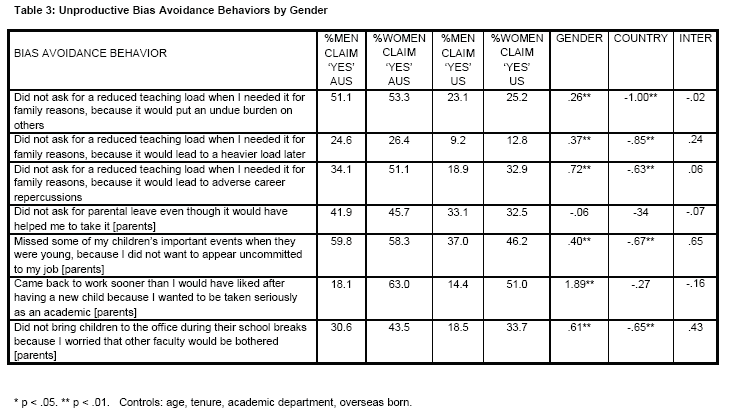"IDEAL WORKERS" AND THE CONCEPT OF BIAS AVOIDANCE
Anne Bardoel* (co-authored with Carol Colbeck, Brian Cooper and Robert Drago)
Abstract
This study analyses bias avoidance behaviors, which arise when individuals minimize or hide family commitments to achieve career success. Two types of bias avoidance behaviors are identified. “Productive” avoidance behaviors occur when caregiving commitments are sacrificed in order to improve work performance and meet the ideal worker norm. “Unproductive” bias avoidance behaviors are behaviors that involve hiding or covering up caregiving commitments, regardless of work performance, to enhance the appearance of being an ideal worker. Using data from Chemistry and English faculty from U.S. and Australian colleges and universities this study addresses three questions.
These are:
(a) are bias avoidance behaviours more common among women?
(b) are bias avoidance behaviours more common in the U.S. or Australia?,
(c) is there an interaction between gender and country in reports of bias avoidance behaviours?
Women are consistently more likely to deploy bias avoidance strategies than men. However, men are not immune, and also reported high levels of unproductive avoidance behaviors. The prevalence of bias avoidance behaviors suggest that the need to keep up appearances and conform to the ideal worker norm is strong for professionals.
Introduction
The Boiled Frog Syndrome
If you put a frog in cold water and gradually heat it up it doesn’t know it’s being boiled and is boiled to death. However, if you throw a frog into boiling water it tries to jump out.
Combining work and care giving responsibilities is a challenge for many employed men and women. Professionals such as doctors, lawyers and academics increasingly expected to function as "ideal workers" who are extremely committed to their jobs and require little time off (Bailyn, 1993; Williams, 2000). The ideal worker norm creates a bias against caregiving in that it is often difficult to make or meet family commitments in addition to extreme job responsibilities. Further, signals of caregiving, even among highly productive employees, may be taken as indicators that the employee is not serious, and hence should not enjoy promotions, pay increases, or substantial assignments.
The hidden assumptions operating at the heart of the ideal worker norm lead many people to feel like the boiled frog - that is, over time it is getting hotter and hotter but just gradually enough that they are becoming habituated to working long hours, spending part or most of every weekend at work, and not questioning whether this is what a just society should demand of its professional employees.
Employees may respond to biases against caregiving by engaging in bias avoidance behaviours (Drago and Colbeck, 2003), whereby individuals either deny themselves opportunities to take on family commitments, or attempt to minimize or hide the existence of family commitments to escape potential career penalties. Bias avoidance strategies that free up more time and energy for a career are labeled “productive.” Examples of productive bias behaviors include delaying marriage or childbearing or limiting the number of children reared. There may also exist “unproductive” bias avoidance behaviors which involve hiding or covering up caregiving commitments, regardless of work performance implications. These behaviors are often only loosely related to performance and include for example, missing important events in a young child’s life in order to attend a meeting where they might contribute little beyond being present or, somewhat differently, lying about absenteeism for family reasons.
Drago and Colbeck (2003) found, for a sample of U.S. academic faculty, that bias avoidance is pervasive and disproportionately effects women. Women may utilize productive bias avoidance strategies more often because they continue to shoulder a disproportionate share of child care and domestic duties; if men shared equally in unpaid work in the home, they might exhibit elevated levels of productive bias avoidance as well. However, women may use unproductive strategies more often because they are more likely to experience bias against caregiving (i.e., women may be viewed as less serious then men for equivalent expressions of caregiving commitments).
In addition to the differences just mentioned, the prototypical career path for academics in Australia is not as formalized as the tenure track system applied to academics in U.S. colleges and universities. In the U.S. system, the individual receives a Ph.D. and typically takes a full-time position as an assistant professor on the tenure track, and can be released during this time with few penalties for the institution.
At the beginning of the fifth year, the faculty member documents her or his accomplishments, and these are reviewed by faculty at other institutions and at various levels within the school. At the end of the academic year, the faculty member is notified as to whether he or she will be promoted to the position of associate professor with tenure, or will instead be released by the institution at the end of the sixth year of employment.
The Australian academic does not have such a formalized process but in order to reach tenure and be promoted Australian academics are judged on the same three criteria of research, teaching and service, with an almost exclusive weight placed on research at the Group of Eight Universities1, but with more weight on teaching performance at the other universities. The analysis may therefore shed some light on the effects of the relatively rigid tenure system in the U.S. Using data from Chemistry and English faculty from U.S. and Australian colleges and universities this study seeks to address three main research questions: (a) are bias avoidance behaviours more common among women?, (b) are bias avoidance behaviours more common in the U.S. or Australia?, and (c) is there an interaction between gender and country in reports of bias avoidance behaviours?
Method
Sample and Procedure
The comparative data reported here are based on a national sample of 5,075 U.S. academics conducted in 2001/2002 and a national sample of 232 Australian academics conducted in 2004.
Characteristics of the samples. Table 1 presents selected demographic characteristics of the two samples broken down by gender. Of the 5,075 U.S. respondents, 39.0% were women, 58.3% men, and 2.7% of undisclosed gender. Of the 232 Australian respondents, 41.4% were women, 56.9% were men, and 1.7% of undisclosed gender. Less than one-quarter of the U.S. women and just over a third of the Australian women were located in Chemistry departments. Although not shown in the Table, in the U.S. sample, women comprised 23.6% of respondents in Chemistry and 50.4% of respondents in English. The corresponding figures for the Australian sample were 24.1% and 71.3%, respectively. Males are slightly older than women in both samples. In both samples, men are more likely to: hold tenure, be parents, and be married or partnered. Australian men had the highest proportion of tenure (82.6%) and U.S. women the lowest (55.0%). Higher rates of parenting were found in the Australian sample, ranging from 40.8% for U.S. women to 66.9% for Australian men.
1 The Group of Eight (GO8) markets itself as the group of 'Australia's Leading Universities'. They support this claim by referring to statistics relating to variables such as research outputs, industry links, graduate outcomes, and the competency of their academic staff. The following universities make up this group: The University of Adelaide, The Australian National University, The University of Melbourne, Monash University, The University of New South Wales, The University of Queensland, The University of Sydney and The University of Western Australia

Measures
Bias avoidance. This variable was measured by 10 items, each rated 1 if present, and 0 if not present. These items were generated from exploratory qualitative research (Drago et al, 2001). The survey was piloted extensively and modified where appropriate prior to administration. Three of the 12 items were identified as measuring “productive” bias avoidance behaviors. The remaining seven items were designed to measure “unproductive” bias avoidance behaviors. Six of the items on bias avoidance were written such that any academic staff member could respond. The remaining four items on bias avoidance were specific to parents, with nonparents asked to skip the relevant section.
Control variables. In our regression analyses, we controlled for age (in years), tenure status (coded 1=tenured, 0=not tenured), department (1 = Chemistry, 0= English), and place of birth (1 = overseas, 0 = local).
Method of Analysis
The first step of the analysis was to examine the percentage distributions of the 10 bias avoidance behaviors across the two samples. A series of binary logistic regression were then used to examine the relationship between gender and each of the bias behaviors, controlling for a range of variables outlined below. The results of these regressions are presented separately for each of the 10 behaviors. Gender was coded 1 if the person was female and 0 if male. Potential country effects were represented by a dummy variable (U.S. = 1, Australia = 0). In addition, a crosscountry interaction between gender and country was included. The product term representing gender and country was included in order to assess whether the effects of gender significantly differed by country. To test the interaction term, variables were centered prior to analysis. The relationships were tested using regression to control for variables simultaneously and to take into account the interrelationships among the independent variables. Listwise deletion was used for missing data. In addition to the control variables identified above, age was also entered as a quadratic (age squared) to test for the possibility that bias avoidance behaviors become more frequent as people enter the prime child-rearing years of the mid-to-late 30s through the early 50s, and then tail off with increasing age.
Results
Table 2 presents results comparing reports of productive bias avoidance behaviors by gender and country. The first two questions were asked of all respondents, while the last was only asked of parents. Pooling across the two samples, we found statistically significant gender differences on the three bias avoidance behaviors, with women more likely to report the behaviors. Surprisingly, no national differences emerged, suggesting that biases against caregiving are equally common in both nations. Given that productive bias avoidance behaviors are likely founded in an unequal division of labor in the home, the insignificant interaction results suggest this source of gender inequality is similar in both nations.

Table 3 presents results comparing unproductive bias avoidance behaviors by gender and country. The first three questions were asked of all respondents, and address potential reasons why an individual did not ask for a reduced teaching load when needed for family reasons. The remaining four items in Table 3 were asked only of parents. Pooling across the two samples, we found statistically significant gender differences on the six of the seven unproductive bias avoidance behaviors, with women more likely to report the behaviors.
The strongest gender effect was observed for the item, “I came back to work sooner than I would have liked after having a new child because I wanted to be taken seriously as an academic.”
Across both samples, over three times as many women as men reported this behavior. On five of the seven behaviors, Australian respondents (irrespective of gender) reported a significantly higher incidence of bias behaviors. This effect was particularly strong for the item, “I did not ask for a reduced teaching load when I needed it for family reasons, because it would put an undue burden on others.” Over 50% of Australian men and women reported engaging in this behavior compared with approximately one-quarter of US men and women. Similarly, just under 60% of Australian men and women reported having “missed some of my children’s important events to appear committed to the job,” compared with just over one third and under one half of US men and women, respectively.
However, there were no statistically significant interactions between gender and country on the seven unproductive bias avoidance behaviors, indicating that the effect of gender was not dependent on country.

Discussion
The research presented in this paper examines the extent to which bias avoidance behaviors are prevalent among U.S. and Australian faculty. There are three main findings of this study.
1. The Australian sample (irrespective of gender) reported significantly higher unproductive bias avoidance behaviors than the U.S. sample.
2. Women irrespective of country reported higher levels of bias avoidance behaviors.
3. There were no significant statistical interactions on any of the bias avoidance behaviors i.e. the effects of gender did not vary by country.
The result that stands out is that whether we consider productive or unproductive bias avoidance behaviors, or such behavior in the aggregate, women are consistently more likely to deploy these strategies in both the U.S. and Australia. Women are more likely than men to sacrifice family in order to maintain their function and appearance as ideal workers. Similar findings have been found in other industries and other western countries. For example, Liff and Ward (2001) found that in a U.K. bank that tacitly rewarded long work hours, the women themselves did not even ask about flexible hours for fear that they would signal that they were not serious about promotion. The likelihood that bias avoidance is both international in scope and highly gendered is troubling not only for proponents of gender equity but also because with regard to unproductive bias avoidance it implies that workplace performance suffers as a result (Bailyn, 1993).
There were statistically significant differences by country on five of the seven unproductive bias avoidance behaviors. In each case Australian academics, irrespective of gender, were more likely to engage in unproductive bias avoidance behaviors. This result suggests that the effects of a relatively stronger social safety net for families and children found in Australia, and the more rigid tenure system found in the U.S., are not strong. Instead, lower levels of unproductive bias avoidance in the U.S. may be an indirect result of a greater emphasis on gender equity in that nation (see also Drago, forthcoming).
In light of the potential role of gender equity in the U.S., it is surprising that there were no statistically significant interactions between gender and country on any of the items for either productive or unproductive bias behaviors. This finding suggests that, to the extent we seek to reduce the incidence of bias avoidance behaviors, men as well as women will need to be involved.
Implications
The results from this study confirm that bias avoidance is prevalent in both the U.S. and Australian higher education sections as faculty feel the pressure to sacrifice themselves at the altar of “keeping up appearances.” However these results also have implications for other professionals such as doctors and lawyers because keeping up appearances could be the mantra for the modern worker trying to balance work and life responsibilities in a world where working long hours is becoming part of the psychological contract between employee and employer. Bias avoidance behaviors appear to be a rational response by individuals to maintain the reality and appearance of commitment to career in a world that penalizes those that do not conform to the ideal worker norm.
In a just society what efforts should professionals make to create a balanced life for individuals as employees and/or caregivers? We argue that creating an environment that supports individuals with caregiving roles requires creating a workplace culture that supports and encourages individuals to integrate their work and personal lives. This involves promoting models for change that challenge the ideal worker norm. These key change mechanisms include developing inclusive work practices that involve workgroups in the redesign of tasks and the implementation of flexible and alternative working time arrangements, providing work/life policies that suit the demographics of the workforce, and engaging in bias resistance activities such as creating a culture of ‘covering’ work and scheduling meetings only during traditional working hours.
* Anne Bardoel, Monash University, Melbourne, Associate Professor, Department of Management and Business (with Carol Colbeck, Penn State University, University Park PA, Brian Cooper, Monash University, Department of Management and Robert Drago, Penn State University, University Park PA
Bibliography/References
Bailyn, Lotte. 1993. Breaking the mold: Women, men, and time in the new corporate world, New York: Free Press.
Drago, Robert. forthcoming. Striking a balance: On work, family and life. Boston MA: Economic Policy Bureau.
Drago and Carol Colbeck. 2003. Final report for the mapping project, The Pennsylvania State University, University Park PA, May [available on-line: http://lsir.la.psu.edu/workfam/mappingproject.htm]
Drago, Ann C. Crouter, Mark Wardell and Billie S. Willits. 2001. Final report for the Faculty and Families project, The Pennsylvania State University, University Park PA, May [available on-line: http://lsir.la.psu.edu/workfam/FFFinalReport.htm]
Friedman, Dana E., Cathy Rimsky, and Arlene Johnson. 1996. College and university reference guide to work-family programs. New York: Families & Work Institute.
Liff, S., & Ward, K. (2001). Distorted views through the glass ceiling: The construction of women's understanding of promotion and senior management positions. Gender, Work and Organization, vol. 8, no. 1, pp. 19-36.
Williams, Joan. 1999. Unbending gender: Why work and family conflict and what to do about it. New York: Oxford University Press.
Copyright 2005. Greek Legal and Medical Conference